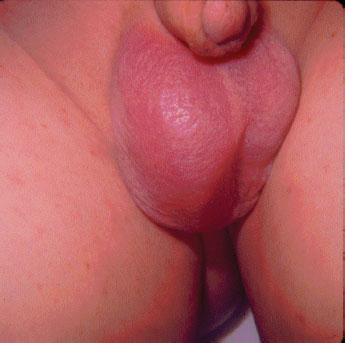Case 22 A teenager with scrotal pain
Adam, a 15-year-old boy, presents to the ED at 10 pm with a 4-hour history of severe right-sided testicular pain. There is no history of any injury or of recent infections. He has no genitourinary symptoms, has never had a urinary tract infection and is not sexually active. He is apyrexial and has an erythematous, swollen scrotum with marked tenderness and swelling of the testes (Case Figure 22.1). The FY2 in the ED department is concerned about the possibility of testicular torsion and calls the surgical ST2 who is also covering urology. The surgical ST2 is busy with a sick patient in the intensive care unit. He tells the FY2 that the urology registrar is on call from home and not in the hospital and asks the FY2 to contact the paediatric team.
Case Figure 22.1 The appearance of Adam’s scrotum. Reproduced with permission from Hutson et al. (2007). Jones’ Clinical Paediatric Surgery, thedn. Wiley-Blackwell, Oxford.

Do you agree with the surgical ST2’s approach?
The paediatric ST3 sees Adam, who is clearly in pain. The urine dipstick shows leucocytes++. The paediatric doctor is also concerned about the possibility of torsion and calls the surgical ST2. The ST2 is still busy, states that the patient may have epididymitis or orchitis and asks the paediatric ST3 to admit Adam to the paediatric ward, prescribe analgesia and arrange an urgent scrotal US for the following morning.
What would you have done?
At 8.30 the following morning Adam is seen by the urology registrar who makes a clinical diagnosis of testicular torsion, cancels the US and arranges urgent surgery to explore the scrotum. In theatre, the left testis is found to be necrotic and is removed and a right sided orchidoplexy is performed.
Adam’s mother complains and later sues the hospital because of the delay in the diagnosis, stating that the testis could have been saved if the diagnosis and treatment had been quicker.
 Expert opinion
Expert opinion
The diagnosis of testicular torsion is primarily a clinical one and in two-thirds of cases the diagnosis can be made from the history and examination alone. There is no need for a scrotal US if clinically the diagnosis is clear. In fact, ordering an US under these circumstances may lead to unnecessary and deleterious delay. If the operation is carried out in less than 6 hours from the onset of symptoms there is a 90–100% chance of saving the testis, beyond 12 hours the chances are 20–50%. Over 24 hours the chance of salvaging the testis is close to 0%. A scrotal US should only be done in doubtful cases.
Epididymitis and epididymo-orchitis are differential diagnosis of testicular torsion. These conditions most commonly occur as a result of reflux of infected urine into the epididymis, or from the sexually acquired diseases caused by chlamydia or gonococcus. The history in these cases is of a more gradual onset of pain, often developing over several days, rather than a few hours of the sudden, severe pain that typifies torsion. Epididymitis and epididymo-orchitis are often accompanied by systemic symptoms such as a fever, symptoms of a urinary tract infection and in some cases a urethral discharge. There may be leucocytes in the urine (25%) and a bacterial growth. However, in 30% of cases of torsion the urine analysis will also show leucocytes, so that this finding may not help differentiate between the above conditions. Orchitis is a further differential of torsion that is most commonly a complication of mumps.
The history and examination in this case are typical of testicular torsion, a common emergency that the surgical ST2 should have known more about. He was also wrong to ignore the concerns of the ED FY2 and the paediatric ST3 who had actually seen the patient. This case comprises a clear urological emergency and in this setting the surgical ST2, as he was very busy, should have obtained the help of the urology registrar or consultant. It was inappropriate and a waste of valuable time to involve the paediatric team. The nature and extent of his supervision should also be looked into. Fortunately, one testis is sufficient to maintain fertility.
 Legal comment
Legal comment
This case needs to be settled as soon as possible. The hospital has clearly failed to treat Adam appropriately and an expert is likely to conclude that earlier treatment would have saved the testicle. The damages will be in the region of £15,000.
A lawyer would tend to look at the mistakes of individual doctors, but this case clearly reveals failings in the systems in place at the hospital. The Key Learning Points below comment on the lack of guidelines for when junior doctors should discuss cases with their seniors and questions the supervision arrangements. But it also mentions something else: respect for the views of other doctors. If the surgical ST2 had listened to the concerns of the paediatric ST3 and FY2, Adam would probably have not lost his testicle. Arrogance and failure to listen to the concerns of others are issues that may need addressing with the surgical ST2 to prevent further errors.



